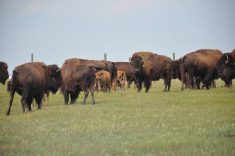Omphalophlebitis, also known as navel ill, can be an ailment in calves.
There are good reasons to keep navel infections down on the farm: calves with lingering infections have poorer weight gains, and yearling bulls that develop infections in their secondary sex glands from navel infection are rendered infertile.
Navel ill is more common when calves are born in damp conditions and in close confinement.
More producers are calving later and frequently on grass, where calves are spread out in a drier environment. This is greatly decreasing the incidence of navel infection.
Read Also

Trump’s tariffs take their toll on U.S. producers
U.S. farmers say Trump’s tariffs have been devastating for growers in that country.
Prevention is also aided by ensuring calves receive lots of colostrum to boost resistance.
Veterinarians prescribe long acting prophylactic antibiotics in herds where the incidence is higher than normal.
There tends to be a higher incidence in herds that practice early season calving and cycle calves through a warm barn. This environment allows foot rot organisms to accumulate over time.
In this situation, try to have a calving area that can be easily disinfected. Bring in only cows that really need assistance. The ideal is to have a calving maternity pen with a concrete floor with a drain so the area can be cleaned and disinfected easily after each use.
I have tried many prevention ideas, including human umbilical clamps, but found they caused more problems then they were worth.
Veterinarians have recognized that navel infection rates are higher with caesarean sections.
Calves come out backward in caesarean deliveries, and the navel cord rips off close to the body. They need the long protective shroud of the umbilicus to prevent infection from wicking up inside.
There are two ways to prevent this.
When a calf comes out through the incision at our clinic, we grab and physically break the protective shroud 30 to 40 centimetres from the navel, which is about the natural distance where the umbilicus breaks off.
Dr. Gordon Adkins of the University of Calgary’s School of Veterinary Medicine has a different method, which is equally effective and a more natural recreation of the real event.
He pulls the entire umbilicus back between the back legs as the calf comes through the incision, which exactly mimics how the umbilicus breaks off in a normal delivery. He has had great success. The umbilical shroud is intact for 30 cm, which prevents infection from wicking up inside.
Mention this to your veterinarian if one of your cows needs a caesarean section because both methods are easy to do and will greatly decrease the incidence of navel infection.
Consider putting calves on prophylactic antibiotics if they flop out of the incision before the procedure can be done or the navel still breaks off short.
Veterinarians usually don’t recommend disinfecting the navel area because many solutions, such as a strong iodine, cause more inflammation and worsen the situation. However, short navels are one situation where I might suggest it. Use something recommended by your veterinarian that is not too harsh.
Short navels are also a problem with backward presented calves. The question is how to break off the shroud internally without breaking the blood vessels because the calf still has to be delivered.
These backward calves may have delayed deliveries, sometimes lack oxygen and are slower to rise and suckle, which predisposes them to navel infection.
Twins are more prone to navel infection because one calf is backward in a high percentage of twin births.














